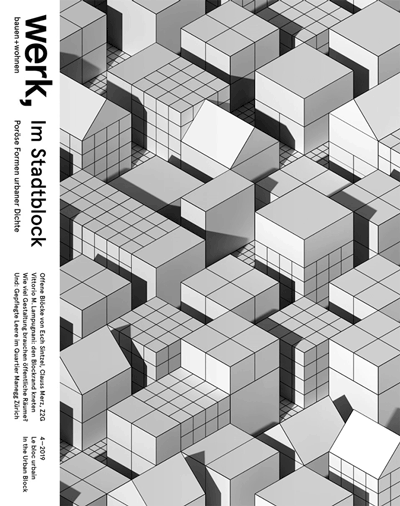werk, bauen + wohnen 3–2019

Renegotiating the Boundaries
Where the block edge is dominant is where you will find the city. This is not just a cliché, as urban life demands density, diversity and immediacy of the kind often offered by the block edge. A number of exponents therefore transfigure the block edge into a panacea that can “make the agglomeration into a city” (cf. NFP 65, Neue urbane Qualität, 2015). Many architects and investors remain sceptical, they criticise the rigidity of rectangular grids, the difficulty of creating good corner solutions, and shadowy courtyards. Among the enemies of the urban block are the current building laws, which are still based on the light and air ideologies of classic modernism.
How can the principle of the block be varied and this type freed from its rigidity? We devote this issue to the “kneading” of the block, the transformation of its contours and the partial opening of its boundaries. Essentially, this “kneading” is nothing new: one hundred years ago architects and town planners were already working on humanizing the block, liberating it from its inflexibility and from the kind of excessive use driven by speculation. In his contribution Vittorio Magnago Lampugnani shows what reform architecture contributed to the rehabilitation of the block – and can again contribute today.
The alignment line approach to urban design in the 19th century resulted in a clear separation of the public and the private realms and a clear hierarchy of the representative front and the rear. If the boundaries of the block are opened up by reform urban planning and “kneaded” volumetrically, then air and light enter into the depths of the courtyards, and new visual relationships and routes become possible. But this also means that the boundaries between public and private tend to blur.
With their hybrid spatial types, the examples in this issue show this clearly. In the Surber Areal in Zurich the side-street on private ground seems more public than the main street itself; in the St Leonhard School in St. Gallen a raised, meaningfully presented space was created. On Maiengasse in Basel the courtyard building opens to the street and the physical thresholds to the private realm are deliberately kept low. In all cases the boundaries must be negotiated in the course of daily use. This, precisely, is the way in which these hybrid forms contribute to the diversity of the urban realm. — Daniel Kurz